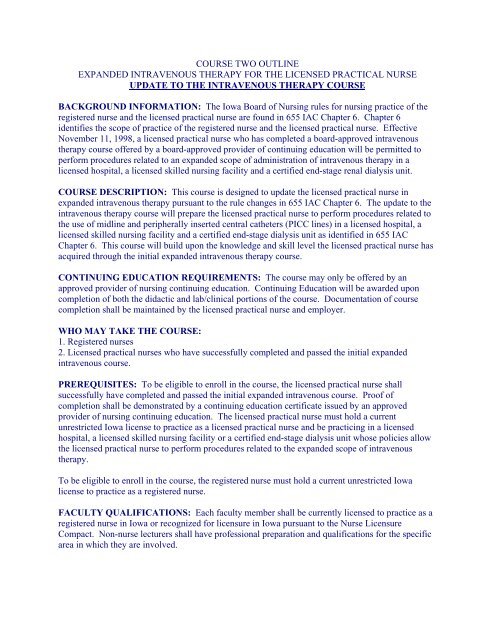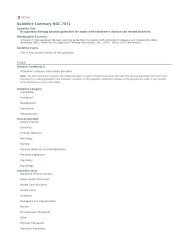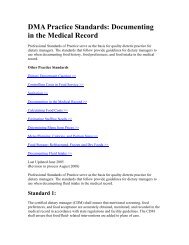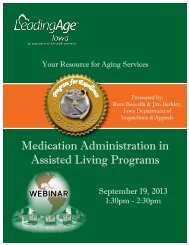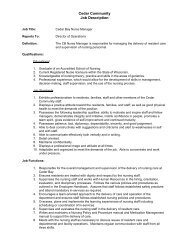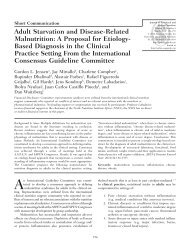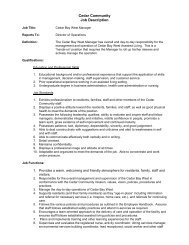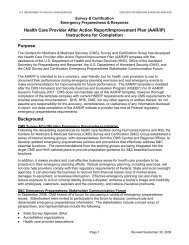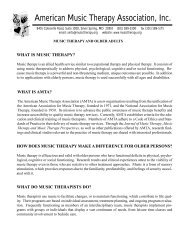COURSE TWO OUTLINE EXPANDED INTRAVENOUS THERAPY ...
COURSE TWO OUTLINE EXPANDED INTRAVENOUS THERAPY ...
COURSE TWO OUTLINE EXPANDED INTRAVENOUS THERAPY ...
You also want an ePaper? Increase the reach of your titles
YUMPU automatically turns print PDFs into web optimized ePapers that Google loves.
<strong>COURSE</strong> <strong>TWO</strong> <strong>OUTLINE</strong><strong>EXPANDED</strong> <strong>INTRAVENOUS</strong> <strong>THERAPY</strong> FOR THE LICENSED PRACTICAL NURSEUPDATE TO THE <strong>INTRAVENOUS</strong> <strong>THERAPY</strong> <strong>COURSE</strong>BACKGROUND INFORMATION: The Iowa Board of Nursing rules for nursing practice of theregistered nurse and the licensed practical nurse are found in 655 IAC Chapter 6. Chapter 6identifies the scope of practice of the registered nurse and the licensed practical nurse. EffectiveNovember 11, 1998, a licensed practical nurse who has completed a board-approved intravenoustherapy course offered by a board-approved provider of continuing education will be permitted toperform procedures related to an expanded scope of administration of intravenous therapy in alicensed hospital, a licensed skilled nursing facility and a certified end-stage renal dialysis unit.<strong>COURSE</strong> DESCRIPTION: This course is designed to update the licensed practical nurse inexpanded intravenous therapy pursuant to the rule changes in 655 IAC Chapter 6. The update to theintravenous therapy course will prepare the licensed practical nurse to perform procedures related tothe use of midline and peripherally inserted central catheters (PICC lines) in a licensed hospital, alicensed skilled nursing facility and a certified end-stage dialysis unit as identified in 655 IACChapter 6. This course will build upon the knowledge and skill level the licensed practical nurse hasacquired through the initial expanded intravenous therapy course.CONTINUING EDUCATION REQUIREMENTS: The course may only be offered by anapproved provider of nursing continuing education. Continuing Education will be awarded uponcompletion of both the didactic and lab/clinical portions of the course. Documentation of coursecompletion shall be maintained by the licensed practical nurse and employer.WHO MAY TAKE THE <strong>COURSE</strong>:1. Registered nurses2. Licensed practical nurses who have successfully completed and passed the initial expandedintravenous course.PREREQUISITES: To be eligible to enroll in the course, the licensed practical nurse shallsuccessfully have completed and passed the initial expanded intravenous course. Proof ofcompletion shall be demonstrated by a continuing education certificate issued by an approvedprovider of nursing continuing education. The licensed practical nurse must hold a currentunrestricted Iowa license to practice as a licensed practical nurse and be practicing in a licensedhospital, a licensed skilled nursing facility or a certified end-stage dialysis unit whose policies allowthe licensed practical nurse to perform procedures related to the expanded scope of intravenoustherapy.To be eligible to enroll in the course, the registered nurse must hold a current unrestricted Iowalicense to practice as a registered nurse.FACULTY QUALIFICATIONS: Each faculty member shall be currently licensed to practice as aregistered nurse in Iowa or recognized for licensure in Iowa pursuant to the Nurse LicensureCompact. Non-nurse lecturers shall have professional preparation and qualifications for the specificarea in which they are involved.
Faculty members will be current, knowledgeable and skillful in the subject matter of the offering byhaving evidence of further education in the subject. Such education shall be acquired through coursecompletion or an advanced degree, or experience in teaching in the specialized area within the threeyears preceding the offering.The ratio of students to faculty in the simulation laboratory shall not exceed 10:1.<strong>COURSE</strong> OUTCOMES: Upon completion of this course, the student will:1. Summarize the major legal implications of intravenous therapy (IV) relative to Iowa Codechapter 152 and 655 IAC Chapters 4 and 6.2. Select IV devices used in administering intravenous solution and drugs, indicating the criteria foruse, precautions, complications of each, and documentation of equipment used, specific to amidline and PICC line sites.3. Be knowledgeable of the anatomy and physiology of central veins.4. Demonstrate the principles of infection control.5. Manage IV therapy to decrease the risk of complications, specific to midline and PICC line sites.6. Analyze the major drugs used intravenously, giving precautions, dose and effects, rate ofinfusion, side effects and reactions, factors controlling stability and compatibility, preparation,and administration of each drug.7. Demonstrate the maintenance and care of the client with a midline or PICC line site and/orinfusion, in a simulated laboratory setting and in a clinical setting in accordance with 655 IACChapter 6.8. Perform techniques for preparing and administering IV solutions and additives in simulated andclinical situations with appropriate supervision, according to agency policy.<strong>COURSE</strong> REQUIREMENTS: In order to pass the course and be awarded a certificate, thefollowing requirements must be met:1. An average score of 80% is required on the unit exams. Tests are to be given throughout thecourse and will reflect content of the unit/s covered.2. Achieve a score of at least 85% on the final exam.3. Demonstrate, with 100% accuracy in the simulation laboratory, the following skills:a. Preparation of IV equipment essential to accurate delivery of IV solution to include selectionof equipment, preparing a bag, preparing a nonvented bottle, priming the tubing, connectingthe tubing to the catheter, setting the drip rate, specific to a midline and PICC line site.b. Change tubing on an existing IV.c. Administration of medication using primary and secondary set.d. Simulation of problem solving approaches when common complications occur, such asinfiltration, kinked tubing, infection.e. Midline/PICC line flush and dressing change.5. Satisfactorily complete the theory portion and the simulation portion of the course prior to theclinical portion of the course. Clinical experience will occur in a licensed hospital, a licensedskilled nursing facility or a certified end-stage renal dialysis unit. Successful completion of eachof the following activities a minimum of 3 times is required for the clinical portion of the course:a. Preparation of IV equipment essential to the accurate delivery of IV solution includingselection of equipment, preparing a bag, preparing a nonvented bottle, priming the tubing,connecting the tubing to the catheter, setting the drip rate.b. Preparation and administration of IV piggyback medication.2
c. Changing the fluid container on an existing IV.d. Midline/PICC line flush and dressing changeEach of these activities is to be performed for clients requiring the services. Students areencouraged to seek the opportunity to perform additional skills identified in the expanded andlimited scope of practice for IV therapy. The Board of Nursing approved provider will documentand maintain records of the student's clinical experiences.BIBLIOGRAPHY: A bibliography of supportive materials that are predominantly less than five yearsold is required. Below is the suggested text book:IV’s Made Incredibly Easy (Current Edition). Philadelphia: Lippincott, Williams andWilkins.The student will spend a minimum of 1 contact hours (50 minutes each) in the simulation laboratoryperforming return demonstrations. The student is allotted credit for the 5-hour laboratory and clinicalportion of the course, upon completion of the laboratory and clinical requirements. The student mustcomplete the clinical portion of the course within 60 days of completing the simulation laboratoryrequirements. An extension may be granted upon the discretion of the instructor and the college.3


